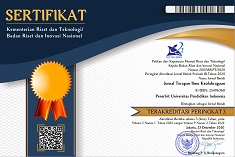Efektivitas Masase dan Terapi Latihan Fleksibilitas Terhadap Pemulihan Rasa Nyeri dan Kelentukan Ekstremitas Bawah Pada Atlet Bulutangkis
Abstract
Penelitian ini bertujuan untuk mengetahui efektivitas masase dan terapi latihan fleksibilitas terhadap pemulihan rasa nyeri dan kelentukan ekstremitas bawah pada atlet bulutangkis. Penelitian ini merupakan penelitian pre-eksperimental. Metode yang digunakan adalah One-group Pretest-posttest Design. Populasi penelitian adalah anggota aktif UKM Bulutangkis Universitas Pendidikan Indonesia sebanyak 14 orang. Teknik sampling yang digunakan dalam penelitian ini adalah Purposive Sampling. Instrumen yang digunakan adalah sit and reach box dan skala numerik nyeri. Teknik analisis yang dilakukan adalah analisis uji-t. Hasil penelitian ini menunjukkan bahwa terdapat efektivitas masase terhadap pemulihan rasa nyeri ekstermitas bawah pada atlet Bulutangkis dengan nilai t-hitung 14,05, rerata 4,54 dan taraf interval kepercayaan 95% dengan nilai terendah 3,85 dan nilai tertinggi 5,23. Terdapat efektivitas latihan fleksibilitas terhadap peningkatan kelentukan ekstremitas bawah pada atlet Bulutangkis dengan nilai t-hitung 5,67, rerata 2,45 dan taraf interval kepercayaan 95% dengan nilai terendah 1,53 dan nilai tertinggi 3,38. Berdasarkan hasil penelitian di atas menunjukkan bahwa masase dan latihan fleksibilitas mampu memberikan perubahan terhadap rasa nyeri dan kelentukan extremitas bawah pada atlet.
Abstract
This study aims to determine the effectiveness of massage and flexibility training therapy for the relief of pain and flexibility in the lower extremities in badminton athletes. This research is pre-experimental. The method used is the One-group pretest-posttest design. The study population is an active member of the Badminton Student Activity Units, Universitas Pendidikan Indonesia as many as 14 people. The sampling technique used in this study is Saturated Sampling or Total. The instruments used were the sit and reach box and a numerical scale of pain. The analysis technique used is t-test analysis. The results of this study indicate that there is effectiveness of massage on the recovery of lower extremity pain in badminton athletes with a t-count of 14.04, a mean of 4.53 and a confidence interval of 95% with the lowest value of 3.84 and the highest value of 5.22. There is the effectiveness of flexibility training to increase the flexibility of the lower extremities in badminton athletes with a t-count of 5.66, a mean of 2.44 and a confidence interval of 95% with the lowest value of 1.52 and the highest value of 3.37. Based on the results of the above research, it shows that massage and flexibility exercises can provide changes to pain and flexibility in the lower extremities in athletes or active members of the Badminton Student Activity Units, Universitas Pendidikan Indonesia.
Keywords
Full Text:
PDFReferences
Anderson, B. (2010). Stretching. Shelter Publications, Inc.
Arovah, N. I. (2010). Dasar-dasar Fisioterapi Pada Cedera Olahraga. N/A.
Basiran. (2009). Massage Untuk Atlet. In Jurnal Kepelatihan Olahraga (Vol. 1, Issue 1).
Fraenkel, J. R., Wallen, N. E., & Hyun, H. H. (2012). How to Design and Evaluate Research in Education. In The McGraw-Hill Companies (Eighth Edi). The McGraw-Hill Companies. https://doi.org/10.1017/CBO9781107415324.004
Graha, A. S., & Priyonoadi, B. (2012). Terapi masase frirage penatalaksanaan cedera pada anggota gerak tubuh bagian bawah. Fakultas Ilmu Keolahragaan Universitas Negeri Yogyakarta, 1–109.
Hadi, S. (2019). Metodologi riset.
Jørgensen, U., & Winge, S. (1990). Injuries in Badminton. Sports Medicine. https://doi.org/10.2165/00007256-199010010-00006
Kaalund, S., Lass, P., Høgsaa, B., & Nøhr, M. (1989). Achilles tendon rupture in badminton. British Journal of Sports Medicine. https://doi.org/10.1136/bjsm.23.2.102
Krøner, K., Schmidt, S. A., Nielsen, A. B., Yde, J., Jakobsen, B. W., Møller-Madsen, B., & Jensen, J. (1990). Badminton injuries. British Journal of Sports Medicine, 24(3), 169–172. https://doi.org/10.1136/bjsm.24.3.169
Mahulkar, S. S. (2016). Relationship of strength and flexibility with skill performance in badminton players. Internatioanl Journal of Physical Education, Sports and Health.
Miyake, E., Yatsunami, M., Kurabayashi, J., Teruya, K., Sekine, Y., Endo, T., Nishida, R., Takano, N., Sato, S., & Kyung, H. J. (2016). A prospective epidemiological study of injuries in Japanese national tournament-level badminton players from junior high school to university. Asian Journal of Sports Medicine. https://doi.org/10.5812/asjsm.29637
Pardiwala, D. N., Subbiah, K., Rao, N., & Modi, R. (2020). Badminton Injuries in Elite Athletes: A Review of Epidemiology and Biomechanics. In Indian Journal of Orthopaedics. https://doi.org/10.1007/s43465-020-00054-1
Shariff, A. H., George, J., & Ramlan, A. A. (2009). Musculoskeletal injuries among Malaysian badminton players. Singapore Medical Journal.
Sukarmin, Y. (2015). CEDERA OLAHRAGA DALAM PERSPEKTIF TEORI MODEL EKOLOGI. MEDIKORA. https://doi.org/10.21831/medikora.v0i1.4702
Yuki Warashina, Ryo Ogaki, Akemi Sawai, Hitoshi Shiraki, & Shumpei Miyakawa. (2018). Risk Factors for Shoulder Pain in Japanese Badminton Players: A Quantitative-Research Survey. Journal of Sports Science. https://doi.org/10.17265/2332-7839/2018.02.003
DOI: https://doi.org/10.17509/jtikor.v5i2.31255
Refbacks
Copyright (c) 2020 Basiran Basiran

This work is licensed under a Creative Commons Attribution-NonCommercial-ShareAlike 4.0 International License.





